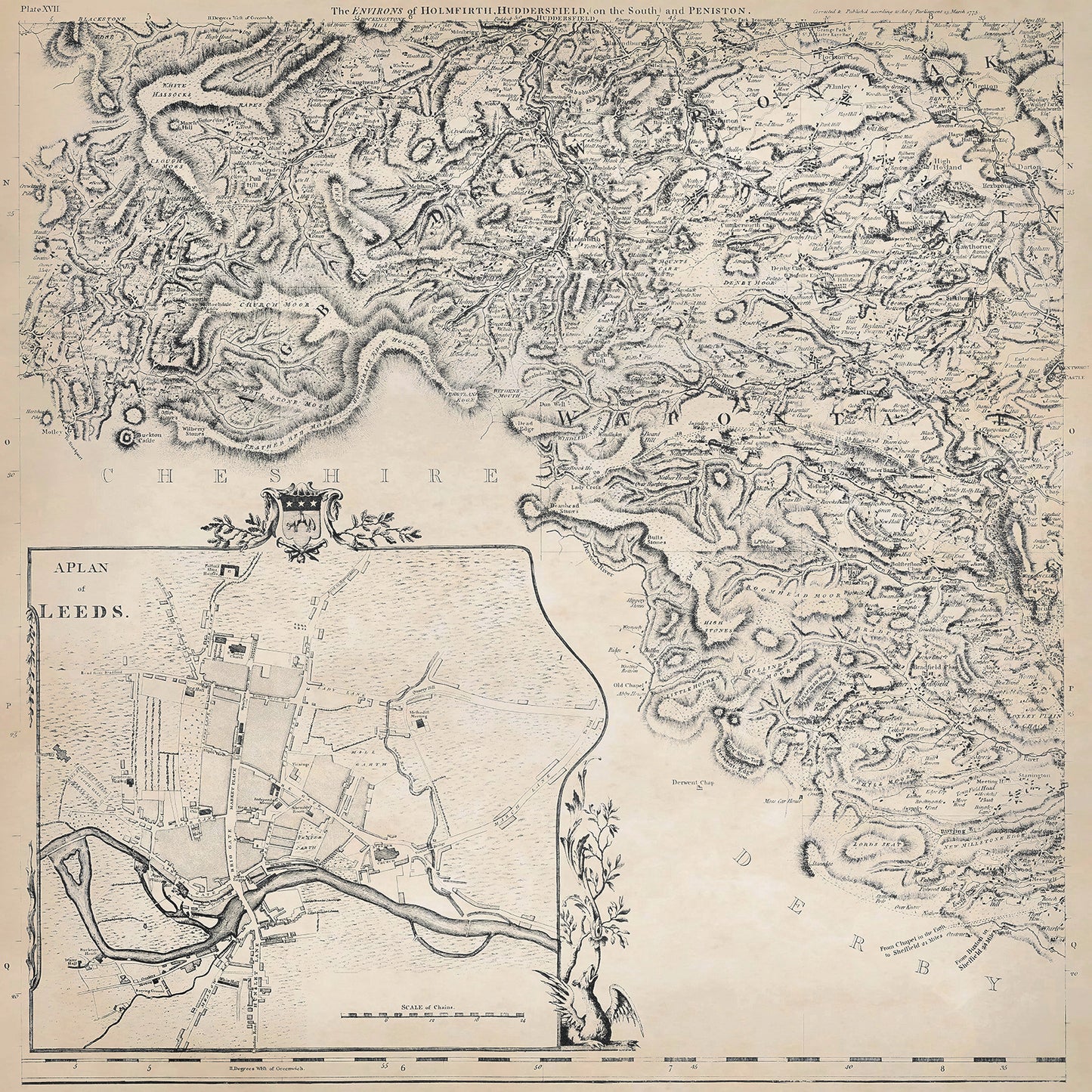Elite Wall Decor
Yorkshire in 1771 sheet 4-1 - features a Plan of Leeds and shows the Holmfirth, Huddersfield (south), and Penistone area
Yorkshire in 1771 sheet 4-1 - features a Plan of Leeds and shows the Holmfirth, Huddersfield (south), and Penistone area
Couldn't load pickup availability
Downloading this large file to phones or tablets is not recommended
This digital download is a high-quality 300dpi JPG image of one sheet from Thomas Jefferys "The County of York Survey'd" published in 1771. The image is crisp, clear and easy to read. It measures 60 x 60 cm, or 7087 x 7087 pixels but can be cropped or resized with the appropriate software. Download now to print whole or in part at home, or simply view it in close up on your device using image software such as Adobe Photoshop, Gimp, Windows Photo, or similar.
PLAN OF LEEDS:
Leeds, in Yorkshire, was a rapidly growing town in the late 18th century, known for its thriving industries and commercial activities.
During this period, Leeds was primarily known for its textile industry. The town had numerous textile mills and factories, specializing in the production of woolen and worsted cloth. Leeds was also involved in the production of linen and flax. The town's skilled craftsmen and artisans were engaged in various trades, such as tailoring, weaving, and dyeing. In addition to textiles, Leeds had industries such as pottery, ironworking, and tanning.
Leeds had several notable landmarks and places of interest in the late 18th century. The Leeds Parish Church (now Leeds Minster) was a prominent religious and architectural site. The town also had a bustling market square, where traders and merchants gathered to sell their goods. The Leeds Infirmary, established in 1771, provided healthcare services to the growing population. Additionally, Leeds was home to elegant Georgian townhouses, reflecting the town's prosperity and growth.
Leeds was also known for its cultural institutions. The Leeds Library, founded in 1768, was one of the oldest subscription libraries in the country. The Leeds Philosophical and Literary Society, established in 1819, promoted science, arts, and education.
The River Aire, flowing through the town, served as a transportation route and provided a picturesque setting.
Holmfirth:
Holmfirth is a town located in West Yorkshire, known for its scenic landscapes and textile industry.
During the late 18th century, Holmfirth's local economy revolved around the textile industry, particularly the production of woollen cloth. The town had numerous small-scale textile mills and workshops where locals engaged in spinning, weaving, and dyeing wool. Some cottage industries also existed, with households involved in various stages of textile production. Additionally, agriculture played a role in the local economy, with farmers cultivating crops and rearing livestock.
Holmfirth's picturesque setting in the Pennine hills made it an attractive destination for visitors. The surrounding countryside offered opportunities for walking, and enjoying the natural beauty of the area. The Holme Valley, with its scenic landscapes and winding river, was a notable feature. The town itself had a few historic buildings and a local parish church, adding to its charm.
Huddersfield:
Huddersfield is a town located in West Yorkshire, known for its textile industry and rich industrial heritage.
During the late 18th century, Huddersfield's local economy was centered around the textile industry. The town was renowned for its production of woollen cloth, with numerous mills and factories operating in the area. Huddersfield was known for its innovative approach to textile manufacturing, including advancements in dyeing techniques and machinery. The town also had a range of supporting industries, such as engineering, ironworking, and coal mining.
Huddersfield had several places of interest in the late 18th century. The town's industrial heritage was reflected in its historic mills and warehouses. The Huddersfield Cloth Hall, built in 1768, was a notable trading center for textiles. The town also had a local market and several public buildings, including the Huddersfield Parish Church.
Penistone:
Penistone is a market town located in South Yorkshire, known for its agricultural heritage and transport links.
During the late 18th century, Penistone's local economy was primarily based on agriculture. The town's rural surroundings supported farming activities, including the cultivation of crops and rearing of livestock. Agriculture played a vital role in supplying the local market and nearby industrial towns with food and raw materials. Some residents may have also been engaged in cottage industries, such as textile production or woodworking.
Penistone had a bustling market that attracted traders and visitors. The town's historic market cross and market hall were central features. Penistone also benefited from its location on major transport routes, including turnpike roads, canals, and later, railways. The town's historic coaching inns provided accommodation and services to travelers passing through the area.

